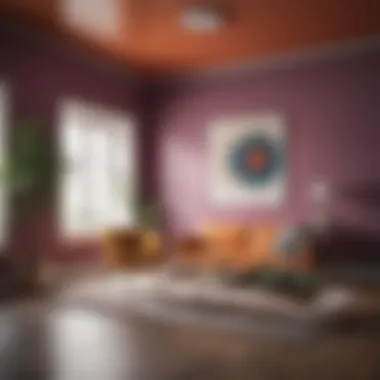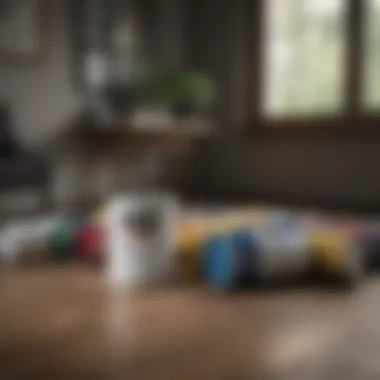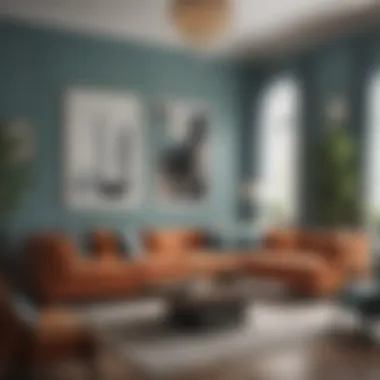Fresh Paint Colors for Living Room: An In-Depth Exploration


Intro
Choosing the right paint color for your living room is more than just picking a shade that looks nice. It involves considering various elements that affect mood, lighting, and overall aesthetics. A successful color choice can elevate the functionality of your space and even reflect your personality.
This article provides insight into fresh paint colors for living rooms, focusing on the latest trends and practical tips. By examining aspects like color psychology and design preferences, you will be equipped to make informed decisions. Let's explore the various components that can guide you through this transformative process.
Preface to Paint Colors in Living Spaces
The choice of paint color in living spaces plays a significant role in shaping the overall atmosphere within a home. It extends beyond mere aesthetics; it influences mood, creates a sense of harmony, and defines the functionality of living areas. Understanding the implications of different colors is crucial for homeowners, interior designers, and anyone involved in creating inviting and comfortable environments.
Color choice contributes to interior design in various ways. The correct colors can evoke feelings of warmth or coolness, energy or relaxation, thereby affecting the daily experiences of those residing in the space. Selecting the right paint colors not only makes a statement but also aligns with personal styles and preferences. This foundational understanding sets the stage for selecting optimal shades during renovations or new constructions.
In today's society, the living room serves multiple functions. It is a space for entertainment, relaxation, family gatherings, and personal retreats. Therefore, the paint colors selected should reflect these diverse uses. A thoughtful palette can unify design elements, enhance the room's layout, and support the intended activities in that space. This article explores the depth of how color selection feeds into a broader narrative of design while emphasizing practical considerations that suit modern living needs.
Understanding Color Psychology
Color psychology plays a vital role in interior design, particularly within the living room. This area of the home serves as a gathering place for family and friends, making the choice of color especially impactful. Understanding how colors influence mood and behavior equips homeowners and designers with the tools necessary to create spaces that reflect personal style and enhance comfort. In this section, we will explore two key elements of color psychology relevant to living room paint selections: the emotional impact of colors and how to choose colors for specific desired moods.
Emotional Impact of Colors
Colors carry inherent emotional weight. Different shades elicit specific feelings and responses. For instance, warmer colors like red and orange can evoke warmth and energy, fostering a lively and stimulating environment. Conversely, cooler shades such as blue and green often induce calmness and relaxation, making them suitable for unwinding after a long day. Understanding these emotional triggers is crucial when selecting paint colors for the living room.
The following colors are commonly associated with certain emotional responses:
- Red: Passion, energy, excitement
- Blue: Tranquility, stability, trust
- Green: Renewal, balance, nature
- Yellow: Happiness, optimism, liveliness
- Purple: Creativity, luxury, calmness
Being aware of these associations can guide you in making choices that align with the atmosphere you wish to cultivate in your living space. When painting your living room, consider how the color will impact your mood and that of your guests.
"Color is a power which directly influences the soul."
– Wassily Kandinsky
Choosing Colors for Desired Moods
Once potential colors are understood, the next step is to align them with the mood you want in your living room. Here, practical considerations must merge with artistic vision. For example, if you often host social gatherings, colors that encourage engagement may be preferable. Bright shades or warm tones can stimulate conversation and activity. On the other hand, if relaxation is the primary goal, opting for muted tones or cooler shades might be the better choice.
Here are some strategies for selecting colors based on desired moods:
- Mood Boards: Creating a mood board can help visualize different combinations and how they might work together.
- Test Samples: Always test paint samples on your walls. Lighting conditions and existing decor can dramatically impact how a color appears once applied.
- Consider Functionality: Factor in how the living room is used. For family-oriented spaces, choose colors that can endure wear and tear while maintaining their emotional effect.
- Set Priorities: Decide what is most important for your space. Is it comfort, energy, or relaxation? This decision will direct your color selection process.
Current Trends in Living Room Paint Colors
In recent times, the living room has become a central hub for family gatherings and social interactions. Understanding current trends in paint colors is essential for homeowners who want to create a compelling and inviting atmosphere. These trends reflect evolving tastes and the desire for personalization in interior design. As paint colors can dramatically alter the perception of a space, it is crucial to consider how these trends can enhance comfort and functionality.
Popular Color Palettes of the Year
Every year brings new palettes to the forefront of design. The popular offerings of this year showcase a blend of comforting neutrals, bold colors, and soft pastels that cater to various tastes. Some notable palettes include:
- Earthy Tones: Shades like terracotta and muted green resonate with a connection to nature. These colors create a grounding effect, making living rooms feel cozy and inviting.
- Soft Blues and Greens: These hues promote tranquility. They are especially effective in spaces designed for relaxation, allowing for a refreshing escape from the hectic pace of life.
- Rich Jewel Tones: Deep blues, greens, and burgundies are emerging as trendy choices for accent walls. They often add drama and a touch of elegance to living spaces.


Zoning in on these color palettes serves several purposes. They help in creating an atmosphere that aligns with personal style while ensuring a harmonious look across the home's interior. Use colors that appeal to your preferences, but do not overlook the importance of balancing them with the elements already present in the room.
Influence of Social Media and Design Platforms
Today, platforms like Instagram and Pinterest play a significant role in shaping home decor trends. Interior design enthusiasts often share their transformations, providing inspiration for potential changes in color. Here are some ways these platforms influence paint color choices:
- Visual Inspiration: Users are exposed to an array of living room styles, encouraging them to explore colors they may not have considered before. This visibility can spark creativity.
- Color Pairings: Posts often illustrate how certain colors complement each other. This can aid homeowners in selecting a palette that is not only attractive but also cohesive.
- DIY Trends: Social media has seen a surge in DIY home improvements. People now share their own painting techniques and results, which can motivate others to take on similar projects with informed choices regarding paint colors.
Exploring Specific Color Themes
Exploring specific color themes is crucial in the context of choosing paint colors for living rooms. This section dives into color categories tailored for distinctive atmospheres and design goals. Each theme can dramatically alter how a space feels and functions. When selecting colors, it's essential to consider how they will integrate with existing elements in your home, affect mood, and complement various style aspirations. The right color can enhance the beauty of a living room while serving a functional purpose. Below are three predominant color themes to ponder as you embark on your painting journey.
Neutral Colors and Their Versatility
Neutral colors are often lauded for their flexibility. These shades provide an ideal backdrop, allowing furniture and decor to stand out. Colors such as beige, gray, and taupe can create a soothing atmosphere. They are easy to match with many types of furnishings. Moreover, neutral tones can change their appearance depending on light conditions. They appear warmer during daylight and cooler in the evening, which adds depth to the living area.
Incorporating neutral tones also makes it simpler to refresh your decor over time. You can easily change accessories, artwork, or furniture styles without needing to repaint. This aspect is particularly attractive for homeowners who appreciate a blend of timeless elegance and modern simplicity.
Bold and Dramatic Tones
Bold colors introduce a dynamic edge to living rooms. Shades like deep blue, emerald green, or rich burgundy can make a strong statement. The powerful presence of these colors often becomes a conversation starter. When used wisely, they can create a focal point in the room.
However, it is essential to balance bold tones to avoid overwhelming the space. Consider pairing them with lighter furniture or decor. This contrast can soften the overall look and enhance comfort. Accents in gold or brass can also add a touch of luxury and warmth, making the space feel both inviting and sophisticated.
Pastel Shades and Subtle Hues
Pastel colors evoke feelings of tranquility and calmness. Soft pinks, lavenders, or mint greens are ideal for those looking to create a peaceful environment. These gentle shades can lighten up small spaces, making them appear larger and more open. Pastels often work well in contemporary or vintage settings, offering a contemporary charm that feels fresh.
When decorating with pastels, keep in mind the importance of balance. These colors can be enhanced with brighter accents, thereby avoiding a washed-out look. Consider using pastel tones for larger areas while incorporating darker, contrasting colors in accessories or wall features.
Practical Considerations When Choosing Paint Colors
Choosing the right paint color is more than just a matter of preference. It involves an analysis of several critical factors that can impact both the aesthetic appeal and functionality of the living room. Understanding these practical considerations can lead to a more satisfying and enduring outcome, ultimately enhancing the living experience in this central space.
By assessing variables such as room dimensions, lighting, existing furnishings, and maintenance requirements, homeowners can make informed decisions that align with their lifestyle and design aspirations.
Assessing Room Size and Natural Light
The physical dimensions of the living room and the availability of natural light are paramount when selecting paint colors. Small spaces can feel cramped if painted in dark shades. Conversely, large rooms might benefit from deeper hues to create intimacy. Conducting a simple test by observing the room at different times of the day provides insight regarding the effect of changing light conditions.
- Natural Light: Rooms with abundant sunlight can bear richer, more vibrant colors without feeling overwhelming. Light colors reflect sunlight and can make a room appear larger and more airy.
- Artificial Light: Consideration also extends to artificial lighting. The type of light bulbs used can affect how paint colors appear. LED warm bulbs can mellow sharp colors, while cooler bulbs might accentuate them.
Complementing Existing Furniture and Decor
The selection of paint colors should also take into account the existing elements within the living room. It is not merely about choosing a standalone color; it involves creating a harmonious environment where everything coexists beautifully.
- Color Harmony: When selecting paint, take stock of the colors and textures present in your furniture and decor. A well-coordinated palette can create a cohesive look.
- Focal Points: If your living room includes statement pieces such as art, a couch, or decor items, consider using paint that accentuates these elements. This can add visual interest and depth to the space.
Longevity and Maintenance of Paint Colors


Longevity is an essential factor in the choice of paint colors. Choosing a color that endures well over time can save homeowners from frequent repaints and maintenance, leading to a more cost-effective solution.
- Durability of Paint: Different finishes have varying degrees of durability. Satin and semi-gloss paints are generally more resistant to stains and easier to clean. Matte finishes, while aesthetically pleasing, may not withstand regular wear and tear as effectively, making them less viable for high-traffic areas.
- Color Fading: Consider the potential for color fading due to sunlight exposure. Some colors may lose their richness over time, requiring touch-ups or complete repaints sooner than expected.
"Paint color is a silent instrument that can shape emotional and physical aspects of life in living spaces."
In summary, practical considerations when choosing paint colors require a thoughtful approach. By assessing room size and natural light, complementing existing furniture and decor, and considering longevity and maintenance, homeowners can ensure that their paint choices contribute positively to the living environment.
Technical Aspects of Paint Selection
In the realm of interior design, understanding the technical aspects of paint selection is paramount. This section delves into essential elements that can significantly influence the overall aesthetic and functionality of a living room. Choosing the right paint finish and being aware of environmental concerns are critical for homeowners looking to create a harmonious living space.
Types of Paint Finishes
Paint finishes present different visual effects and durability, making them a fundamental consideration when selecting paint for your living room. Each type serves distinct purposes and contributes to the room's ambiance. Here is a brief overview of several paint finishes:
- Matte Finish: This finish provides a non-reflective surface that helps hide wall imperfections. It creates a soft, warm feel, making it suitable for cozy spaces. However, it can be harder to clean and maintain.
- Eggshell Finish: Slightly more reflective than matte, eggshell paints offer a balance between aesthetics and ease of cleaning. They are often used in moderate-traffic areas.
- Satin Finish: This finish has a velvety sheen that is durable and easy to wipe down. It is great for rooms that require some washability, like living rooms.
- Semi-Gloss and Gloss Finish: Both finishes provide high reflectivity and durability. They are excellent choices for trim and accents, as they can withstand wear and tear and are easy to clean.
When selecting the right finish, consider the function of the room, the expected level of traffic, and how easily you need to maintain the walls.
Understanding VOCs and Environmental Impact
Volatile Organic Compounds (VOCs) are chemicals found in many traditional paints. They can evaporate into the air and contribute to indoor air pollution. Being mindful of VOC content is essential for creating a healthy living environment, particularly for those with sensitivities to chemicals.
- Health Concerns: High levels of VOCs can lead to respiratory or allergic reactions. Low-VOC or zero-VOC paints are recommended for those wishing to promote better indoor air quality.
- Environmental Stewardship: As the awareness of environmental issues rises, opting for paints with reduced VOCs is becoming a responsible choice. These paints minimize air pollution and the adverse effects on ecosystems.
- Label Awareness: Familiarize yourself with paint labels that provide VOC content. Selecting brands with lower levels aligns with sustainable living practices.
"Choosing low-VOC paints is not just an aesthetic decision, but also one that influences health and ecological balance."
Understanding both the types of finishes available and the implications of VOC usage will empower homeowners to make informed decisions that enhance both the beauty and the well-being of their living spaces.
The Role of Accent Walls
Accent walls serve as a powerful tool in interior design, providing a focal point within a living room. Their strategic use can dramatically change the perception of space, influencing both aesthetic appeal and emotional response. An accent wall is typically painted in a color that contrasts with the other walls in the room. This creates visual interest and can draw attention to certain design elements, such as artwork or furniture.
The choice of an accent wall can affect the room's overall mood. Using a bold hue can convey energy and make a room feel more alive, while softer shades can create a sense of calm and comfort. Therefore, thinking carefully about the placement and color choice of an accent wall is essential for achieving the desired ambiance.
Before selecting an accent wall, it is important to consider a few key elements. First, the size of the room can dictate the effectiveness of an accent wall. In smaller spaces, for instance, a dark or saturated color might make the room feel cramped. In contrast, in larger rooms, a bold accent can provide a vibrant contrast against lighter shades. The amount of natural light and its direction also play a significant role. A well-lit wall can showcase colors more vividly than one that is shadowed.
Accent walls enable homeowners to express their unique style while setting the overall tone of the room.
Choosing an Accent Wall Color
Choosing the right color for an accent wall requires a thoughtful approach. Undoubtedly, functionality and aesthetic appeal should guide decisions. When considering colors, one must evaluate the existing furnishings and decor items.
It is helpful to select a color that complements, rather than clashes with, the main palette of the living room. A popular method is to refer to a color wheel, where complementary colors can enhance the overall design. For example, if the majority of the room is in cool tones like blues or greens, a warm hue like coral or deep red may provide an appealing contrast.
Here are some considerations for selecting an accent wall color:


- Harmonizing with Accessories: Look for colors that echo similar tones found in cushions, artwork, or rugs.
- Mood and Intention: Select colors based on the emotional atmosphere desired; for relaxation, soft blues or greens work well, while vibrant yellows or oranges energize.
- Test Before Committing: Always trial paint samples on the wall. Lighting can change how a color looks at different times of the day.
Balancing Accent Colors with Room Aesthetics
Once the accent wall color is chosen, it is crucial to balance it with the room’s overall aesthetics to maintain cohesion. This balance helps to avoid the room feeling disjointed or chaotic.
To achieve this harmony, focus on creating connections between the accent wall and other elements in the room. One effective strategy is to incorporate accessories and decor that echo the color of the accent wall. For instance, if a homeowner chooses a rich forest green for the accent wall, using that same shade in smaller decor items like vases or throw pillows can connect the room visually.
Additionally, consider the texture and finish of materials that surround the accent wall. For example, if the wall is matte, pairing it with glossy or textured furnishings can create depth.
The final aim is to cultivate an atmosphere that feels integrated and sophisticated.
Styling Tips for Incorporating Paint Colors
Incorporating paint colors effectively into your living room is essential to the overall feel of your space. These styling tips focus on harmonizing colors with your decor and accessories. This ensures that the applied colors enhance the visual appeal while maintaining comfort and functionality. The right paint choice can affect light perception and mood, emphasizing the importance of thoughtful application.
Coordinating Decor and Accessories
Coordinating decor and accessories with your chosen paint color is vital. The aim here is to create synergy between your walls and the items within the room. Start by examining existing furnishings. Consider their colors, materials, and styles.
- Choose a Color Palette: Select a primary color that matches or complements your paint. This can be done by choosing shades in similar warmth or hue.
- Accent Pieces: Use smaller decor items, such as pillows, throws, and rugs, to introduce variations in color without overwhelming the main palette. This allows for creative expression while remaining cohesive.
- Artwork: Incorporate artwork that draws from the paint color. This ties the room together and adds a personalized touch. If your wall is a bold color, consider more neutral artwork to balance the intensity.
- Use Natural Elements: Incorporate plants or wooden accessories that add texture and contrast. Natural greens work well with most paint colors, bringing life and freshness to the space.
This method of coordination not only ensures an aesthetically pleasing look but also creates a welcoming atmosphere for guests.
Layering Textures to Enhance Color Depth
Layering textures is an effective way to add depth to your painted walls. A monotone color scheme can fall flat without the right textural contrasts. Explore different materials to create visual interest while maintaining harmony.
- Fabrics: Choose a mix of fabrics for your furniture and accessories. Soft textiles, such as velvet or linen, tend to soften bold paint colors and can make the living room feel luxurious.
- Rugs: A patterned rug can break the monotony of solid wall colors. Look for rugs that incorporate colors from the wall and decor.
- Mixed Materials: Blend materials like metal, wood, and glass in your decor. For example, a wooden coffee table can ground a room with bold painted walls, while metallic elements can add light and vibrancy, enhancing the overall color experience.
"The right mix of textures creates an engaging living room, allowing paint colors to stand out without overwhelming the senses."
In summary, these styling tips guide homeowners, interior design enthusiasts, and hosts in effectively using paint colors within their living spaces. By coordinating decor and accessories and layering textures, you can create a dynamic, harmonious environment that reflects your personal aesthetic.
Finale: Making Informed Color Choices
In exploring fresh paint colors for living rooms, making informed color choices emerges as a pivotal theme. This article highlights that the choices you make regarding paint colors aren't mere aesthetic decisions. They influence the ambiance of a space and reflect personal style and preferences. A well-considered color palette can transform a living room into a sanctuary of comfort or a lively space for gatherings.
The benefits of informed decision-making in selecting colors extend beyond visual appeal. Understanding color psychology, the impact of natural light, and current trends ensures your choices harmonize with your lifestyle. Factors such as room size and existing decor further guide effective selections. A cohesive color scheme enhances the overall aesthetics of the home.
It's important to weigh the emotional reactions different colors evoke. For instance, soft blues often promote tranquility, while vibrant yellows can inspire creativity and energy. Therefore, aligning color selections with mood goals elevates the living space experience.
The overall takeaway is that informed choices promote not only aesthetic benefits but also enhance the functional aspects of living spaces.
Recap of Key Points
- Understanding Color Psychology: Color has emotional connotations and can alter perceptions of space.
- Current Trends: Recognizing popular palettes helps in making selections that remain stylish and relevant.
- Practical Considerations: Assessing natural light, room size, and existing decor ensures that your color choices are practical.
- Technical Aspects: Knowledge of paint types and finishes is essential for durability and performance.
- Accent Colors: Accent walls can serve as focal points and help balance the overall design.
Encouraging Individual Expression in Design
Interior design is an expression of identity and personality, particularly in living rooms, where family and guests gather. Choosing paint colors should be an enjoyable exercise in creativity. It's key to trust your instincts and think beyond existing trends—personal taste should guide decision-making.
Consider experimenting with colors that resonate with you emotionally. If a bold hue makes you feel alive, embrace it. Conversely, if you prefer calm tones, let those guide your choices. Individuality can also shine through by mixing different shades within a cohesive palette. Unique combinations foster a creative space that tells your story.
Additionally, consider that each choice contributes to the story of your living room. From wall colors to accent pieces, every element adds depth to the narrative of your home. Emphasizing personal expression in design solidifies the connection between inhabitants and their spaces.















